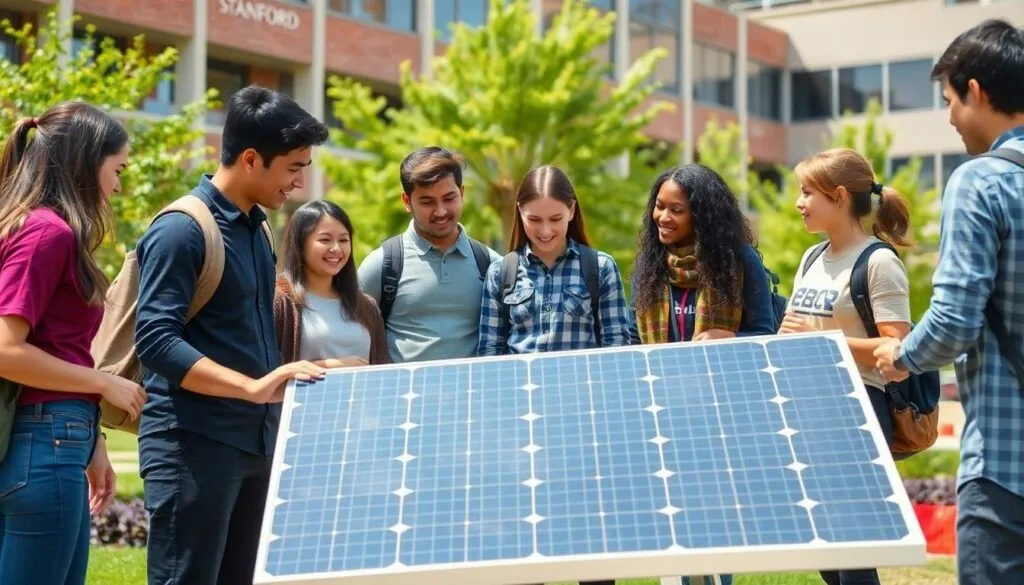In a world where energy demands are skyrocketing faster than a caffeine-fueled college student on finals week, Stanford University is leading the charge with groundbreaking innovations. This isn’t just another tech hub; it’s a powerhouse of creativity and intellect, where brilliant minds tackle the planet’s most pressing energy challenges.
From solar panels that double as art installations to smart grids that could outsmart a chess champion, Stanford’s energy research is anything but ordinary. With a mix of cutting-edge technology and a sprinkle of academic wizardry, they’re not just dreaming about a sustainable future—they’re building it. Buckle up as we explore how Stanford is turning the energy landscape upside down, one innovative idea at a time.
Table of Contents
ToggleOverview of Stanford Energy Innovation
Stanford University leads in energy innovation, addressing the challenges posed by global energy demands. The university’s approach combines cutting-edge research with a commitment to sustainability. Projects like artistic solar panels showcase how creativity meets functionality in energy solutions.
Research initiatives focus on smart grids, enhancing efficiency and reliability in energy distribution. Collaboration with industry partners plays a critical role in translating academic advancements into real-world applications. The Stanford Energy System Innovations initiative exemplifies this integration, aiming to optimize energy use across campus and beyond.
Programs at Stanford prioritize the development of renewable energy technologies. Wind and solar energy projects demonstrate a clear commitment to reducing carbon footprints. Additionally, energy storage solutions receive considerable attention, addressing one of the major barriers to widespread renewable adoption.
Interdisciplinary research at Stanford fosters exploration in fields like materials science, economics, and environmental policy. Faculty members engage students in hands-on experiences, enabling them to contribute to ongoing projects. This engagement cultivates future leaders equipped to tackle energy challenges.
Global partnerships extend Stanford’s influence in energy innovation. Collaborating with institutions around the world enhances research capabilities and accelerates the development of effective, sustainable solutions. Stanford’s emphasis on innovation positions it as a driving force in reshaping the energy landscape through transformative technology and research.
Key Areas of Research

Stanford University focuses on several critical areas of research to drive energy innovation and tackle emerging technologies.
Renewable Energy Technologies
Innovative research in renewable energy technologies stands at the forefront of Stanford’s projects. Teams concentrate on advancing solar and wind energy systems, enhancing efficiency and effectiveness. Researchers examine new materials and designs to improve solar panels and develop cutting-edge wind turbine configurations. Collaborations with industry partners enable the university to test these innovations in real-world settings. Furthermore, innovations like artistic solar panels illustrate the unique approach Stanford takes toward renewable energy applications.
Energy Storage Solutions
Energy storage plays a pivotal role in the transition to renewables, and Stanford prioritizes advancements in this field. The research community investigates new battery technologies, including lithium-ion and solid-state options. Insights from interdisciplinary teams foster the development of energy storage systems that can meet fluctuating energy demands. These solutions are essential for ensuring a reliable power supply as reliance on intermittent renewable sources increases. Additionally, research into grid-scale storage systems can help balance supply and demand effectively.
Smart Grids and Energy Efficiency
Smart grids represent a significant area of focus for Stanford, aiming to enhance energy efficiency across various platforms. Researchers work on integrating advanced communication technologies with traditional power grids. Such innovations help manage energy distribution more effectively and reduce waste. Studies examine the use of data analytics and artificial intelligence to optimize energy usage in real-time. By prioritizing smart grid solutions, Stanford contributes to a more sustainable energy future, helping communities adapt to evolving energy needs.
Impact on Sustainable Development
Stanford University’s energy innovations significantly contribute to sustainable development by promoting environmental stewardship and economic growth. These efforts integrate renewable energy technologies and innovative research methodologies.
Contributions to Climate Change Mitigation
Stanford’s research on renewable energy technologies targets climate change mitigation effectively. Academic teams focus on enhancing solar and wind systems to lower greenhouse gas emissions. Projects like artistic solar panels demonstrate alternative energy sources’ viability while engaging the public. Moreover, energy storage solutions ensure reliability despite the intermittent nature of renewables, helping to stabilize electric grids. Initiatives emphasize the urgency of adopting sustainable practices to meet global climate targets and ultimately support a healthier planet.
Economic Benefits and Job Creation
Stanford’s energy innovations fuel economic growth by creating jobs and driving industry advancements. Collaborations with businesses translate academic research into market-ready solutions, fostering new ventures. Energy projects generate employment opportunities within the local community and beyond. A focus on smart grids and storage technology enhances workforce development in high-demand fields. As the clean energy sector expands, Stanford plays a pivotal role in shaping a sustainable economy, benefiting local and global communities alike.
Collaborations and Partnerships
Stanford University fosters numerous collaborations and partnerships to advance energy innovation and emerging technologies. Engaging with diverse stakeholders enhances research capabilities and accelerates the deployment of sustainable energy solutions.
Academic Collaborations
Academic collaborations at Stanford involve interdisciplinary efforts across various departments. Researchers work together on projects focusing on renewable energy technologies, energy storage solutions, and smart grids. These partnerships encourage knowledge exchange and provide students with valuable hands-on experiences. In initiatives like the Stanford Energy System Innovations, academic teams optimize energy use while directly engaging with local communities. Collaboration with other leading universities and research institutions enhances Stanford’s research output and broadens the scope of innovation.
Industry Partnerships
Industry partnerships play a crucial role in Stanford’s energy innovation strategy. Collaborating with businesses allows academic research to transition into real-world applications. These partnerships often result in cutting-edge technologies that address critical energy challenges. For example, joint projects focus on developing new battery technologies and enhancing grid efficiency. Through initiatives with industry leaders, Stanford drives economic growth, creating jobs and fostering new ventures within the energy sector. This synergy ensures that research translates into viable market solutions, benefiting both the university and the broader community.
Future Directions in Energy Innovation
Stanford University emphasizes future energy solutions through numerous innovative initiatives. Research into solar technology sees ongoing advancements in efficiency and affordability. Developing new energy storage systems remains a priority, ensuring a stable power supply from fluctuating renewable sources.
The exploration of smart grid technologies represents another significant avenue of research. Integrating artificial intelligence and data analytics optimizes energy distribution and usage, ultimately enhancing overall energy efficiency. Collaborations with industries play a key role; these partnerships fast-track the application of research findings, bringing cutting-edge solutions to market.
In addition, Stanford focuses on fostering interdisciplinary approaches. Engaging students from different academic backgrounds nurtures creativity and broadens perspectives in energy solutions. This collaborative spirit extends to global partnerships, allowing for the exchange of ideas and practices across various regions.
Renewable energy technologies, such as wind and solar systems, continue to drive research efforts. New materials and design concepts aim at maximizing performance while reducing carbon footprints. By prioritizing climate change mitigation, Stanford’s projects serve as models for sustainable development.
Engagement with local communities supports further outreach. Initiatives that inform the public about energy innovations strengthen the connection between research and real-world impact. Promoting environmental stewardship alongside economic progress positions Stanford as a leader in energy innovation, setting a benchmark for future advancements.
Stanford University’s commitment to energy innovation is reshaping the future of sustainable solutions. By integrating advanced technologies with academic research, the university is tackling pressing global energy challenges head-on. Its focus on renewable energy and smart grid systems not only enhances efficiency but also drives economic growth through job creation and industry partnerships.
The collaborative spirit at Stanford fosters a dynamic environment where interdisciplinary research thrives. This approach ensures that cutting-edge ideas are translated into practical applications, benefiting both local communities and the global landscape. As Stanford continues to pioneer advancements in energy technology, it sets a powerful example for others to follow in the quest for a sustainable future.





